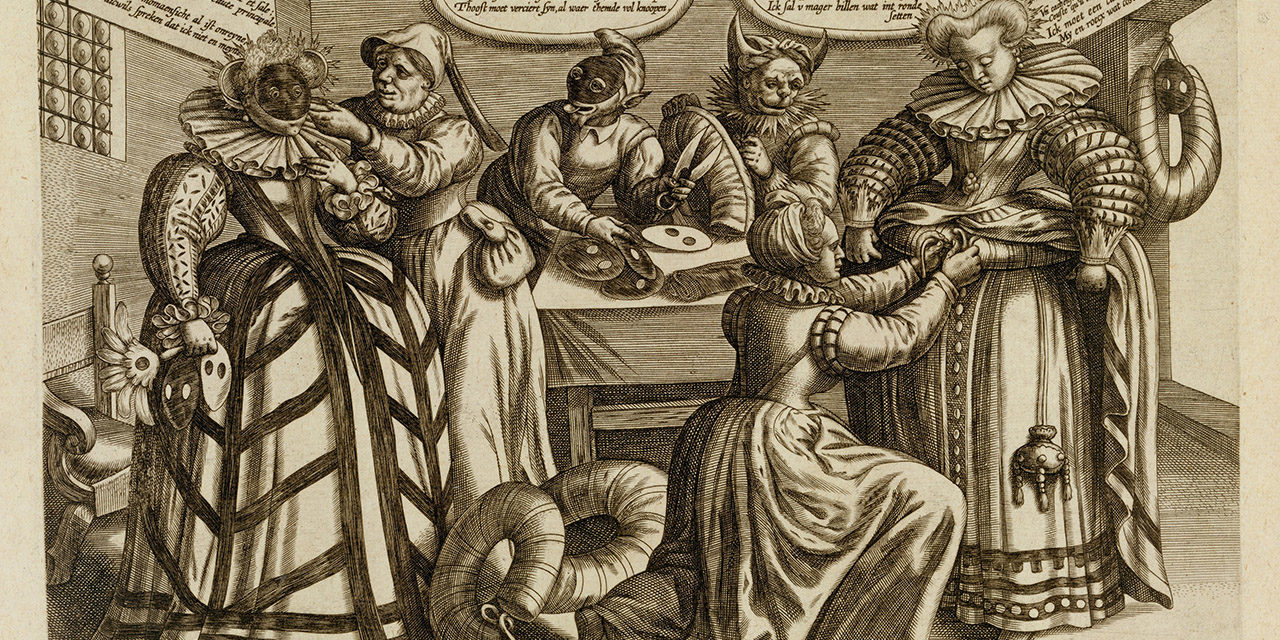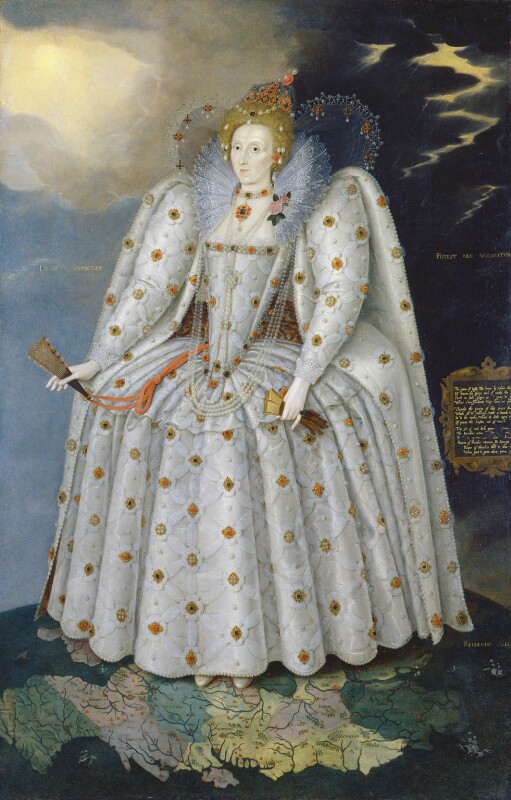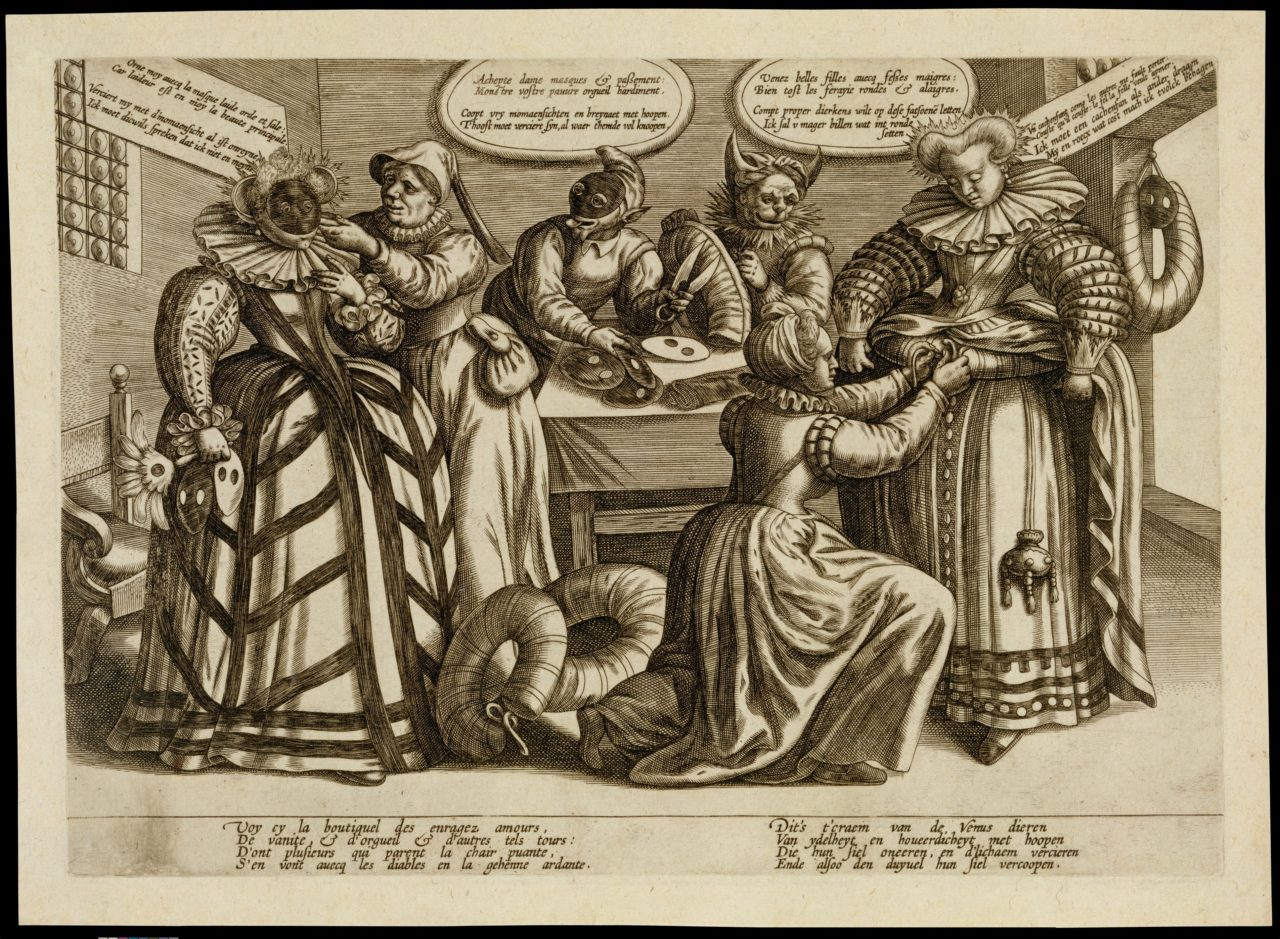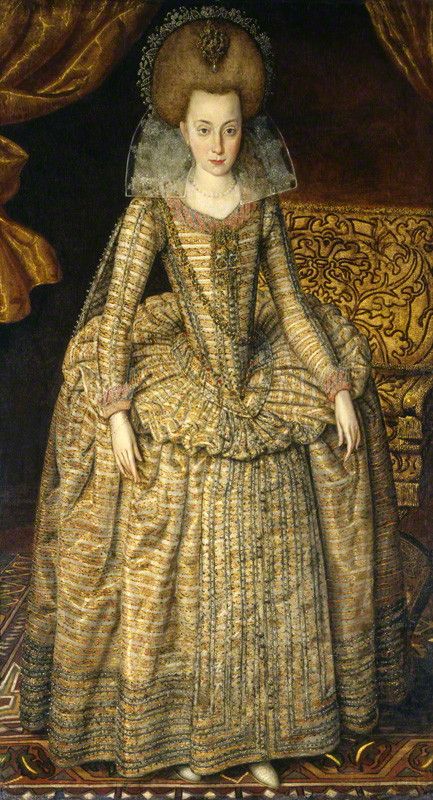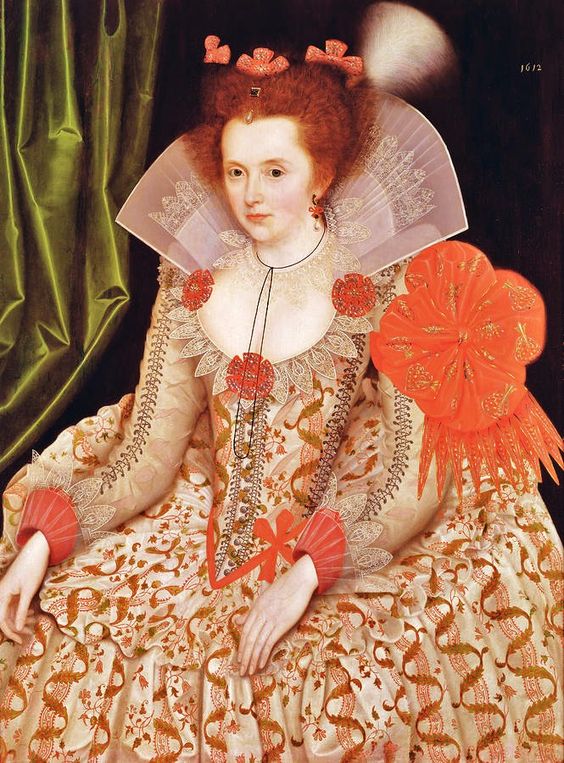A roll of padding tied around the hip line to hold a woman’s skirt out from the body in the late 16th and early 17th centuries.
The Details
I
n their Handbook of English Costume in the Sixteenth Century (1970), C. Willett and Phillis Cunnington write:
“The Roll Farthingale, popularly known as the ‘Bum Roll’, was a padded roll, variously covered with cotton or other bombast, and sometimes wired.”
In Costume in the Drama of Shakespeare and His Contemporaries (1972), M. Channing Linthicum elaborates:
“This roll was placed around the hips and the pleated skirt of the kirtle allowed to fall over it. A variation of this roll was used by 1580. Instead of a complete roll, a half roll, made by stuffing only part of it, was placed behind ‘like a rudder to the body’, leaving the front straight. It was called a ‘half-‘, ‘demi-‘ or ‘semi-circled’ farthingale, the kind which Falstaff assured Mrs. Ford that she could wear gracefully.”
Queen Elizabeth’s 1592 portrait (Fig. 1) reveals the effect of just such a bum roll, softening the line created by the farthingale. A 16th-century Dutch caricature (Fig. 2) features several bum rolls lying in the foreground and a woman helping another tie hers on, giving an idea of their typical size and shape. They were thought ridiculous by some contemporaries as this caricature suggests; Susan J. Vincent in The Anatomy of Fashion: Dressing the Body from the Renaissance to Today (2009) quotes a period reaction to the bum roll:
“As one contemporary wrote, ‘Fardingales aboue the Loynes to waire, That be she near so bombe-thin, yet she cross-like seem’s foure-squaire’—or to paraphrase, no matter how ‘bum thin’ a woman might be, see her side on in one of these, and she appears square and squat.”
That is the bum roll made the waist appear artificially small and the hips/bum oversized. In an article on “Fashion Trends in the Early Seventeenth Century” in Arts and Humanities Through the Eras, the role of the bum roll is discussed further:
“To accentuate the lines of these English farthingales, it became common to tie a bum roll around a woman’s waist so that the skirt stood out even further from the farthingale’s structure.”
Mechthild Müller in “Early History of Dress and Fashion in Continental West Europe” (2010) echoes that point:
“For a short time in the early years of the seventeenth century, there was a break in the triangular line during which the bum roll was worn—a padded roll tied around the waist under the petticoats that distended the silhouette at the hips.”
The effect of these early 17th-century bum rolls can be seen in portraits of Elizabeth Stuart, later Queen of Bohemia (Figs. 3-4).
Ninya Mikhaila in The Tudor Tailor: Reconstructing 16th-century Dress (2006) offers instructions on how to create a bum roll today:
“Cut piece in linen canvas or strong calico. Pin together and sew around, leaving a 12.5-15cm (5-6in) gap on the inside line. Nip and notch seam allowance. Turn through. Fill very firmly with wool or cotton fibre. Hand sew opening closed. Sew on ties made from cotton or linen tape using strong thread. “
Fig. 1 - Marcus Gheeraerts the Younger (Flemish, 1561-1636). Queen Elizabeth I ('The Ditchley portrait'), ca. 1592. Oil on canvas; 241.3 x 152.4 cm (95 x 60 in). London: National Portrait Gallery, NPG 2561. Bequeathed by Harold Lee-Dillon, 17th Viscount Dillon, 1932. Source: NPG
Fig. 2 - Attributed to Maerten de Vos (Netherlandish, 1532–1603). The Vanity of Women: Masks and Bustles, ca. 1600. Engraved paper. New York: The Metropolitan Museum of Art, 2001.341.1. Purchase, Irene Lewisohn Trust Gift, 2001. Source: The Met
Fig. 3 - Robert Peake the Elder (British, 1551-1619). Princess Elizabeth (1596–1662), Later Queen of Bohemia, 1610. Oil on canvas; 171.3 x 96.8 cm (67 1/2 x 38 1/8 in). London: National Portrait Gallery, NPG 6113. Purchased, 1991. Source: NPG
Fig. 4 - Marcus Gheeraerts the Younger (Flemish, 1561-1636). Elizabeth Stuart, Queen of Bohemia, 1612. Source: Wikimedia
References:
- Cunnington, C. Willett, and Phillis Cunnington. Handbook of English Costume in the Sixteenth Century. London: Faber and Faber, 1954. http://www.worldcat.org/oclc/362761.
- “Fashion Trends in the Early Seventeenth Century.” In Arts and Humanities Through the Eras, edited by Edward I. Bleiberg, James Allan Evans, Kristen Mossler Figg, Philip M. Soergel, and John Block Friedman, 116-117. Vol. 5, The Age of the Baroque and Enlightenment 1600-1800. Detroit: Gale, 2005. Gale Virtual Reference Library (accessed October 7, 2016). http://libproxy.fitsuny.edu:2200/ps/i.dop=GVRL&sw=w&u=fitsuny&v=2.1&it=r&id=GALE%7CCX3427400835&asid=070bd3507540ef609a2e5c05b780b3ad
- Linthicum, M. Channing. Costume in the Drama of Shakespeare and His Contemporaries. New York: Hacker Art Books, 1972. http://www.worldcat.org/oclc/255251664.
- Mikhaila, Ninya, and Jane Malcolm-Davies. The Tudor Tailor: Reconstructing 16th-Century Dress. Hollywood: Costume and Fashion Press, 2006. http://www.worldcat.org/oclc/937528534.
- Müller, Mechthild. “Early History of Dress and Fashion in Continental West Europe.” In Berg Encyclopedia of World Dress and Fashion: West Europe, edited by Lise Skov, 47–56. Oxford: Berg, 2010. Accessed August 14, 2018. http://dx.doi.org/10.2752/BEWDF/EDch8010a.
- Vincent, Susan J. “Hips and Bottom.” In The Anatomy of Fashion: Dressing the Body from the Renaissance to Today, 61–96. Oxford: Berg, 2009. Accessed October 07, 2016. http://dx.doi.org/10.2752/9781847888617/ANAOFFASH0004.

